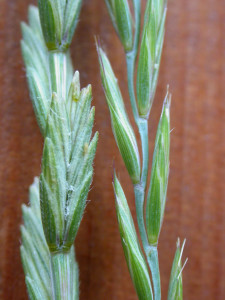
One of the selected CSP projects involves sequencing intermediate wheatgrass (Thinopyrum intermedium), depicted on the left. The hairy glumes and lemmas are characteristic of Agropyron intermedium trichophorum. The right-hand specimen is of Agropyron repens, which co-occurs with Agropyron intermedium but has awn-tipped glabrous lemmas. (Matt Lavin, CC BY-SA 2.0 Wikimedia Commons)
Intermediate Wheatgrass (IWG) is a highly productive perennial grass species that is being developed as a new biomass and grain crop. As a perennial crop, IWG can provide essential ecosystem services to current agricultural practices such as stabilizing soil with its deep root structure, reducing nutrient runoff, and limiting weed growth. IWG produces biomass quantities similar or greater than switchgrass, with the added potential of >1,000 kg/ha of grain that can be substituted for wheat in food products with minor changes to recipes. There have been significant efforts to improve IWG through traditional breeding. There remains an immediate need for new crops that provide both economic value and ecosystem services, and the rapid development of such species will enable society to immediately reap the potential benefits. These crops epitomize a potential solution for the call of sustainable intensification and meeting feedstock production needed for biofuels and hold great promise to increase the resilience of agricultural systems in light of serious environmental issues facing agriculture.
Proposer’s Name: Jesse Poland, Kansas State University